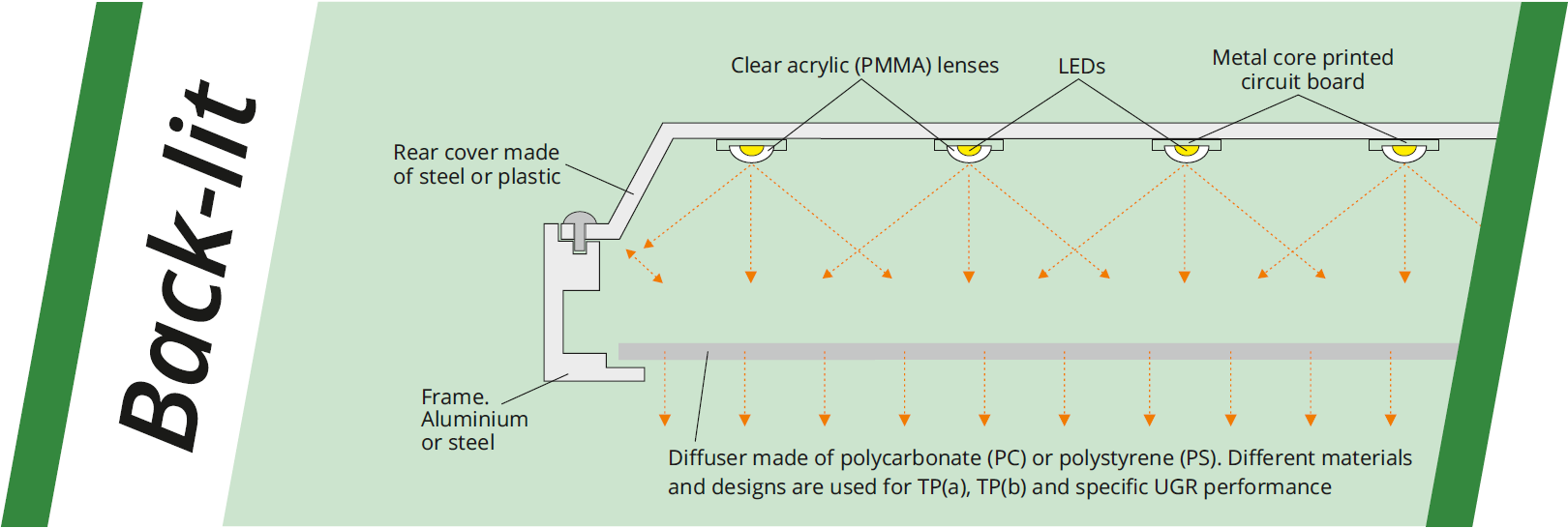A back-lit LED panel is made of an array of LEDs fitted on a horizontal plate shining vertically down through a diffuser into the space to be illuminated. Back-lit panels are sometimes also known as direct-lit panels.
An edge-lit LED panel is made of a row of LEDs attached to the frame (or circumference) of the panel, shining horizontally into a light-guide plate (LGP). The LGP directs the light downwards, through a diffuser into the space below. Edge-lit panels are sometimes also known as side-lit panels.
Are edge-lit or back-lit LED panels best?
Both designs have advantages and drawbacks. Edge-lit panels were the first to be mass-produced.
The edge-lit design was chosen for several reasons:
- A light-guide plate (LGP) is an effective and simple way to diffuse the light, avoiding the risk of bright spots.
- The presence of the LGP means that the diffuser is not solely responsible for spreading the light evenly so low-cost materials can be used, provided they don’t yellow with age.
- No lenses are required and the edge-lit design functions well with a variety of different LED beam angles.
- Heat from the LED chips is dissipated via the frame, so the rear can be light-weight and it won’t get hot, so the driver can be placed here if required.
Over time the drawbacks of this approach made themselves apparent. The best material for an LGP is acrylic (PMMA), but this can be quite expensive, so cheaper polystyrene (PS) was often used. If it is not blended with UV stabilising additives, PS LGPs turn yellow over time so efficiency falls, the light output turns a dull yellow and the centre of the panel darkens while the periphery remains bright.
In addition, some rear reflectors (see diagram above) peeled away with age further degrading the performance of early edge-lit LED panels.
Technical advances have now allowed a new generation of back-lit LED panels to be introduced. These are often more efficient with lower unit costs than previous LED panels.
- LEDs have become more efficient, so the thermal advantage inherent in the side-lit design became less important. Back-lit designs are no longer so hot that the driver cannot be placed on the rear.
- Lenses have become cheaper to produce and modern adhesives mean that they can be securely fixed to each LED to create an even light distribution without the risk that they will fall off – a failing with some earlier and cheaper back-lit panels.
- Micro-prismatic diffusers have become more common, less expensive and more effective, so the double action of the LGP/diffuser combination is no longer required.
- The elimination of the LGP in back-lit designs means that the potential energy savings are greater than with edge-lit designs, if all other factors are equal.
The lighting market now accepts back-lit panels as readily as edge-lit panels and, because back-lit panels require no LGP or rear reflector, they are often the lowest cost as well as the most efficient LED panels available.
What are the problems with cheap back-lit LED panels?
This is what to look out for.
- Too few LEDs being used. Too few LEDs (generally 36 or less) means that they have to be driven at a high current to generate the light output needed. Compared with designs using more LEDs, this is less efficient (LEDs perform most efficiently with low drive currents), generates more heat, shortens the life of the LEDs and hastens the lumen depreciation.
- Plastic bodies. The better back-lit panels use a metal body. This is more effective as a heat sink than a (cheaper) plastic body. LEDs generate some heat and this needs to be dissipated if their life is not to be shortened further.
- Light distribution not overlapping. In a good back-lit panel each LED is individually lensed and the lenses are designed so that the light from each LED overlaps the light from its neighbours. This will produce an even lit affect and some resilience in the event that a single LED fails. Poor lens design and a low number of LEDs is likely to decrease the overlap between LEDs and increase the risk of bright and dark spots on the front of the fitting.
- Are the lenses firmly fixed in position? Only time will tell, but the risk is that the heat generated by the LEDs, combined with cheap adhesive poorly applied, will cause the lenses to fall off. The result will be uneven light distribution and possibly glare too.
- Built-in driver. Manufacturers can save money by building the driver into the body, but this has multiple drawbacks. It can’t be replaced in case of a problem and there will be no dimming or emergency options. It is a very inflexible approach.
- Check the corners of the frame. On the cheaper panels an unsightly joint will be evident.
UGR <19 with back-lit and edge-lit LED panels.
Both designs can, with the right front cover, produce excellent UGR performance. To compare different brands and models look at the UGR tables that are part of the photometric data that should be available from all reputable manufacturers.
Post time: Jan-13-2021






